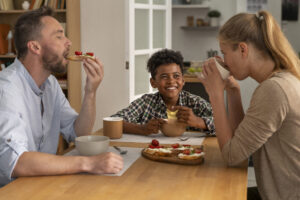Welcome again! It’s great that you want to get better at your English skills. This article will look at the meals people eat from breakfast to dinner. Your confidence when writing or speaking about food in English will increase if you understand these fundamental words and ideas. So, take your time and join me on this easy journey to discover common foods and how people talk about them. By the end, you will be able to use these words with confidence in your own English writing and conversations.
Breakfast – Beggining the Day Right
Breakfast is the first meal that people eat after waking up in the morning. It is essential because it gives you the energy you need to start the day. You feel alert and ready for the day after a filling breakfast.
People usually eat light, simple foods for breakfast. Common breakfast fare consists of:
- Bagels, toast, or bread
- Eggs can be fried, scrambled, boiled, or made into an omelet.
- Berries, oranges, and bananas are examples of fresh fruits.
- Milk and cereal or oatmeal
- Yogurt
- beverages such as fruit juice, tea, or coffee
In many countries, breakfast is considered essential since it “breaks the fast” after a night’s sleep. Some people eat simple breakfasts, while others prefer larger meals to keep them feeling full.
Lunch – The Midday Meal
Most people eat lunch in the early afternoon or at noon. Especially in the United States and many European nations, it is often the largest meal of the day. You need the energy from lunch to stay focused and continue your day.
Lunch usually consists of a main course that includes protein, vegetables, and carbs. Lunch fare typically consists of:
- Fish, beef, pork, or chicken
- Bread, potatoes, pasta, or rice
- salads or cooked veggies such as beans, peas, or carrots
- stews or soups, particularly on chilly days
- Sometimes, for a quicker lunch, wraps or sandwiches
Often, lunch is a group meal. A wonderful way to relax and enjoy your time together is to eat together at home, at work, or at school.
Snack – Small Meals Between Main Meals
A snack is a small meal that is eaten between meals, like breakfast and lunch or lunch and dinner. Snacks help you keep your energy levels steady and keep you from feeling too hungry right before your next big meal.
Typical snacks include:
- Berries, grapes, and apples are examples of fresh fruit.
- Nuts such as peanuts or almonds
- Crackers and cheese
- Small sandwiches or yogurt
- Popcorn, granola bars, or cookies
Snacking can also be a healthy habit if you choose healthful foods. You should refrain from consuming excessive amounts of sugary snacks if you wish to keep your health in check.
Dinner – The Evening Meal
People typically eat dinner in the evening after finishing work or school. Dinner may be lighter than lunch in some cultures, but it may be the largest meal in others.
Typically, dinner consists of vegetables, a protein source, and a side dish like potatoes or rice. Typical dinner fare includes:
- Grilled, baked, or roasted meat or fish
- Steamed or sautéed vegetables like broccoli, spinach, or carrots
- Rice, potatoes, or pasta
- Soups or salads
Some people prefer to pair their dinner with a beverage like juice, tea, or water. After a hectic day, dinner is a time to unwind, spend time with loved ones, and savor a peaceful meal.
Desserts – Delightful Concessions Following Meals
Desserts are sweet foods that are usually eaten after lunch or dinner. Although they are popular treats that many people enjoy, they are not necessary. Desserts add enjoyment to meals and get-togethers.
Common desserts consist of:
- Various flavors of ice cream
- Cakes such as fruit, vanilla, or chocolate
- Pies, like pumpkin pie or apple pie
- Brownies and cookies
- Custards or puddings
- Fresh fruit paired with honey or cream
Desserts are delicious, but it’s best to limit your intake because they often contain high levels of sugar.
Write and Develop Your Writing Ability
Knowing the names and times of meals will help you communicate in everyday English. Studying breakfast, lunch, snacks, dinner, and desserts will help you understand what to expect and how to talk about food in English.
Remember that writing with these words and sentences will help you get better over time. Try utilizing new words in brief sentences each day to gain comfort.
If you keep practicing, you’ll see your English gradually getting better.
Now is the Time to Practice!
To help reinforce your learning, try answering the following questions. These short exercises are designed to test your understanding and help you reflect on the key points of the article. Take your time and assess your writing skills.
Writing Lessons
Who is eating?
Who is drinking?
How many people are having breakfast?
How many people are smiling?
The child neither eats ___ drinks.
A bit more practice. English sounds very natural in the video below. To fully comprehend everything that is said, watch it as many times as necessary, both with and without subtitles.
Este vídeo pertence ao canal English Chit Chat — assista mais no canal oficial.
Vocabulary
| Word | Meaning |
|---|---|
| Meal | Any eating time (breakfast, lunch, dinner) |
| Main course | The central, largest dish of a meal |
| Side dish | A smaller dish served with the main course |
| Appetizer | Small food eaten before the main course |
| Dessert | Sweet food after the main course |
| Beverage | A drink |
| Hungry | Wanting to eat |
| Full | Not hungry anymore after eating |
Now that you’ve learned about types of meals, click on the post right bellow to see the next post about writing.
English Writing for Daily Practice Lesson 3 – Writing Can Improve Your Life















